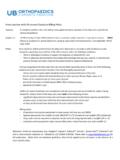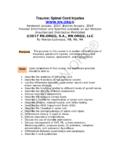Transcription of Evaluation of Concussion Post Concussion Syndrome
1 Evaluation of Concussion & post Concussion Syndrome Presented By: John Leddy, MD FACSM FACP Associate Professor of Clinical Orthopedics Medical Director- UB Concussion Management Clinic Program Director - University at Buffalo Sports Medicine Fellowship Barry Willer John Baker David Pendergast Karl Kozlowski Les Bisson John Marzo Jim Donnelly Len Financial assistance provided by The Buffalo Sabres Foundation Robert Rich Family Foundation PUCCS Foundation Ralph Wilson Fund UB Concussion Management Clinic UB Neurosurgery UB Neurology (adult and pediatric) Dent Neurologic Institute Excelsior Orthopedics Buffalo Orthopedics Buffalo Spine and Sports Medicine UB Department of Physiology and Biophysics UB Department of Physical Therapy, Exercise and Nutrition Sciences UB Department of Rehabilitation Sciences UB Department of Psychiatry UB Department of Nuclear Medicine UB Department of Orthopedics and Sports Medicine (Niagara Falls) Buffalo Neuroimaging and Analysis Center (BNAC)
2 UB Speech and Hearing Center UB School of Nursing UB School of Health and Health Related Professions UB Department of Biostatistics Buffalo Bills and Buffalo Sabres WNY Concussion Management and Research Interest Group University at Buffalo University of Rochester SUNY Upstate at Syracuse SUNY Albany Others?? Contact Upstate NY Thruway Concussion Consortium 1 in 4 young people will have at least one Concussion before they finish/leave high school Twice as likely among boys Most often from sports (teenagers) or falls (children) million/yr. in US. How often does a Concussion occur? young people will have at least one Concussion before they finish/leave high school Twice as likely among boys ONE IN Most often from sports (teenagers) or falls (children) million each year in the US A blow to the head that results in an altered state of consciousness Represented by confusion May or may not have unconsciousness Almost always some level of amnesia (memory loss) - post traumatic amnesia - Retrograde amnesia What is a Concussion ?
3 Confusion amnesia unconsciousness fMRI demonstrates activation patterns that correlate with symptom severity and recovery in Concussion . While not part of routine assessment at the present time, such methods provide additional insight to pathophysiological mechanisms. Alternate Neuro Imaging Composite of metabolic activity associated with simple math questions in PCS pre-Rx. Wide range of activity is unfocused and inefficient. Composite reveals efficient and focused attention to math questions in PCS post -Rx. This is similar to non-injured controls. Math-SRT PCS (N=3) #1- Head is the moving object and comes to an abrupt stop Does not have to hit an object, whiplash alone is sufficient Less common: Head is hit by a moving object How does a Concussion happen?
4 It is the movement of the brain inside the skull that causes the damage Damaged neurons (Diffuse axonal injury) produce neurotoxins and a cascade of metabolic changes What happens to your brain? Metabolic Cascade after Concussion History of trauma causing significant cerebral Concussion 1. Is there acceleration deceleration of the head? Is there a possible whiplash effect on the neck? 2. Is there evidence of amnesia/confusion? 3. Is there a history of Concussion ? When, how many and how long to recover from each? History Establishing a pre-morbid history of migraine headaches, depression, anxiety, ADHD, or learning disability is also crucial since TBI can exacerbate these conditions and they in turn can be responsible, if only partially, for ongoing symptoms.
5 History Common Acute Symptoms of Cerebral Concussion Somatic Somatic NeurobehavioralNeurobehavioral CognitiveCognitive Headache Drowsiness Feeling slowed down Nausea Fatigue/lethargy Feeling in a fog or dazed Vomiting Sadness/depressed Difficulty concentrating Balance problems/dizziness Nervousness/irritability Difficulty remembering Sensitivity to light/noise Sleeping more than usual Numbness/Tingling Trouble falling asleep Blurred vision/diplopia/ flashing lights Tinnitus Once first aid issues are addressed, then an assessment of cognition should be made. Focused neuro exam: Check the eyes and balance. Assess at rest and, if athlete says symptoms have resolved, after exertion.
6 On-field or Sideline Evaluation of Acute Concussion Assessment of concentration (drills of stating the months of the year in reverse and a series of digits backwards tests) and memory (recall of 3 words at 5 minutes) and examination of the cranial nerves. The Romberg test, tandem gait, and oculomotor testing (smooth pursuits, saccades, accommodation) should also be performed because vestibular deficits may persist for up to 10 days after Concussion . After the neurologic examination, the cervical spine should be carefully assessed for tenderness, spasm and range of motion. Physical Examination Published studies have identified postural stability deficits lasting approximately 72 hours following sport-related Concussion .
7 Balance Classic Cushing response occurs with intracranial hypertension. systemic hypertension, bradycardia, and respiratory depression. On Field: persistence of high BP and high pulse pressure (systolic diastolic > 60 mmHg) combined with bradycardia. May signal a cerebral bleed. Vital Signs McCrory P, Meeuwisse W, Johnston K, Dvorak J, Aubry M, Molloy M, and Cantu R. Consensus Statement on Concussion in Sport 3rd International Conference on Concussion in Sport held in Zurich, November 2008. Clinical Journal of Sport Medicine. 2009;19(3):185-200. Consensus Statement on Concussion in Support 3rd International Conference on Concussion in Sport Zurich, November 2008.
8 The player should not be left alone following the injury, and serial monitoring for deterioration is essential over the initial few hours following injury. A player with diagnosed Concussion should not be allowed to return to play on the day of injury. Formerly, NFL allowed adult athletes to return to play on the same day as the injury but not any more. On-field or Sideline Evaluation of Acute Concussion NO There are data demonstrating that, at the collegiate and high school level, athletes allowed to RTP on the same day may demonstrate NP deficits post -injury that may not be evident on the sidelines and are more likely to have delayed onset of symptoms and prolonged recovery.
9 RTP Same Day? Neuro Imaging Brain CT (or, where available, MRI) contributes little to Concussion Evaluation but should be employed whenever suspicion of an intra-cerebral structural lesion exists. Examples of such situations may include prolonged disturbance of conscious state, focal neurological deficit or worsening symptoms. Who should go to the ER? Prolonged LOC (seconds-minutes, not one second ) Seizure or focal neurologic deficit Unilateral dilated pupil Deteriorating Clinical Status Declining level of consciousness Worsening headache, emesis Concussion Management Cornerstone of Concussion management as of 2012 is physical and cognitive rest until symptoms resolve, and then a graded program of exertion prior to medical clearance and return to play.
10 Concussion Management Physical AND cognitive rest is required. Activities that require concentration and attention ( , scholastic work, videogames, text messaging, etc.) may exacerbate symptoms and possibly delay recovery Best Treatment for Concussion in the Early Stages (14 days) Avoid contact sports or any activity where there is a risk of a subsequent head injury. Second Impact Syndrome Consensus Statement on Concussion in Sport 3rd International Conference on Concussion in Sport Zurich, Novemeber 2008 Majority(80%-90%) of concussions resolve in a short (7-10 day) period, although the recovery time frame may be longer in children and adolescents. Zurich: Computerized Neurophychological Assement ImPact, ANAM, etc.




